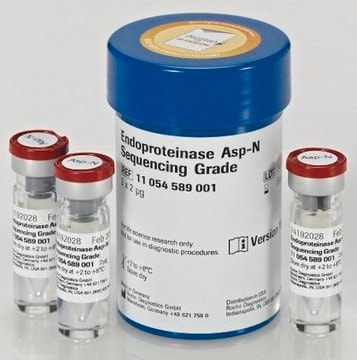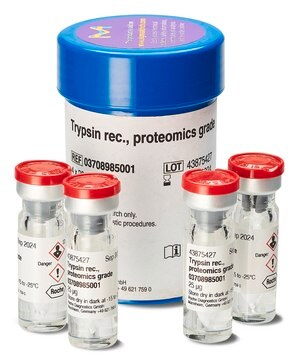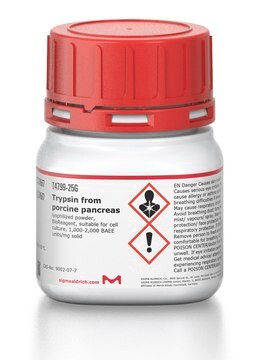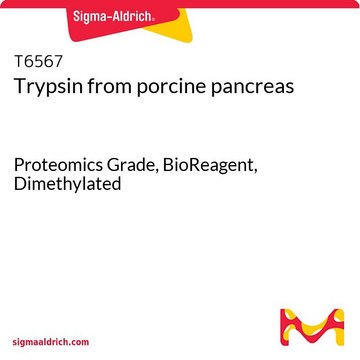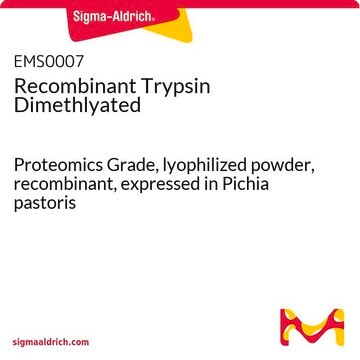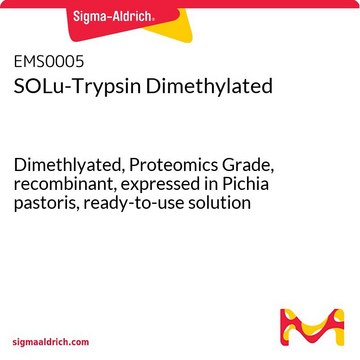Wszystkie zdjęcia(1)
Kluczowe dokumenty
TRYPSEQ-RO
Roche
Trypsin Sequencing Grade
from bovine pancreas
Synonim(y):
trypsin
Zaloguj sięWyświetlanie cen organizacyjnych i kontraktowych
About This Item
Polecane produkty
pochodzenie biologiczne
bovine pancreas
Poziom jakości
Formularz
lyophilized (salt-free)
aktywność właściwa
≥80 units/mg protein
masa cząsteczkowa
Mr 23.5 kDa
opakowanie
pkg of 4 × 100 μg (11047841001)
pkg of 4 × 25 μg (11418475001)
producent / nazwa handlowa
Roche
optymalne pH
8.0
temp. przechowywania
2-8°C
Powiązane kategorie
Opis ogólny
Trypsin Sequencing Grade is isolated from bovine pancreas as a highly purified and specific protease. Trypsin Sequencing Grade is a serine endopeptidase. It specifically cleaves peptide bonds at the carboxylic side of the basic amino acids Arg and Lys. Amide and ester bonds of Arg and Lys are also cleaved.
Specyficzność
The specificity of Trypsin Sequencing Grade is verified with the oxidized B-chain of insulin (insulin Box) as substrate. High concentrations of Trypsin Sequencing Grade (1 part by weight enzyme with 18 parts by weight insulin Box) are incubated for 18 hours to detect traces of chymotrypsin impurities.
Specificity (HPLC, with Insulin Box):
Cleavage after 1 hour: ≥90%;
Unspecific cleavage products after 18 hours: ≤10%
Specificity (HPLC, with Insulin Box):
Cleavage after 1 hour: ≥90%;
Unspecific cleavage products after 18 hours: ≤10%
Zastosowanie
Trypsin Sequencing Grade is used to to digest proteins in solution, in gels or on blotting membranes.
The enzyme is used for protein-structure elucidation, tryptic mapping, fingerprinting, sequence analysis, and translocation studies. Trypsin Sequencing Grade generates glycopeptides from purified glycoproteins and is suited for the digestion of proteins in polyacrylamide gels.
The enzyme is used for protein-structure elucidation, tryptic mapping, fingerprinting, sequence analysis, and translocation studies. Trypsin Sequencing Grade generates glycopeptides from purified glycoproteins and is suited for the digestion of proteins in polyacrylamide gels.
Jakość
Purity: Free of impurities that may interfere with the separation of peptides in reversed-phase HPLC.
Uwaga dotycząca przygotowania
Stabilizers: Trypsin is stable in 4 M.
Working concentration: 1/100 to 1/20 of the protein by weight (in solution); 1-5 μg/100 μl (for in-gel digest)
Storage conditions (working solution): A solution in 0.01% trifluoroacetic acid (TFA), (v/v) or 1 mM HCl may be used for one week at maximum, if stored at 2 to 8 °C. By incubation of proteins in solution at neutral to slightly basic pH-values partial autolysis might occur. For this application, Roche recommends Trypsin, Modified, Sequencing Grade.
Working concentration: 1/100 to 1/20 of the protein by weight (in solution); 1-5 μg/100 μl (for in-gel digest)
Storage conditions (working solution): A solution in 0.01% trifluoroacetic acid (TFA), (v/v) or 1 mM HCl may be used for one week at maximum, if stored at 2 to 8 °C. By incubation of proteins in solution at neutral to slightly basic pH-values partial autolysis might occur. For this application, Roche recommends Trypsin, Modified, Sequencing Grade.
Rekonstytucja
Reconstitution in acid is necessary for stability of solution: 0.01% TFA (v/v), 1 mM HCl or 0.1% acetic acid are recommended.
Inne uwagi
For life science research only. Not for use in diagnostic procedures.
Ta strona może zawierać tekst przetłumaczony maszynowo.
Hasło ostrzegawcze
Danger
Zwroty wskazujące rodzaj zagrożenia
Zwroty wskazujące środki ostrożności
Klasyfikacja zagrożeń
Eye Irrit. 2 - Resp. Sens. 1 - Skin Irrit. 2 - STOT SE 3
Organy docelowe
Respiratory system
Kod klasy składowania
11 - Combustible Solids
Klasa zagrożenia wodnego (WGK)
WGK 1
Temperatura zapłonu (°F)
does not flash
Temperatura zapłonu (°C)
does not flash
Wybierz jedną z najnowszych wersji:
Masz już ten produkt?
Dokumenty związane z niedawno zakupionymi produktami zostały zamieszczone w Bibliotece dokumentów.
Klienci oglądali również te produkty
Saeedreza Vessal et al.
Journal of proteome research, 11(8), 4289-4307 (2012-07-07)
Protein expression patterns in imbibed seeds of three cultivars of chickpea (Cicer arietinum L.) with different rates of germination under limiting water supply in soil (>10% water holding capacity) were compared. A large number of soluble proteins expressed earlier and
Jesper V Olsen et al.
Molecular & cellular proteomics : MCP, 3(6), 608-614 (2004-03-23)
Almost all large-scale projects in mass spectrometry-based proteomics use trypsin to convert protein mixtures into more readily analyzable peptide populations. When searching peptide fragmentation spectra against sequence databases, potentially matching peptide sequences can be required to conform to tryptic specificity
Petra A Neff et al.
Chemphyschem : a European journal of chemical physics and physical chemistry, 8(14), 2133-2137 (2007-08-28)
A silicon-on-insulator (SOI) based thin film resistor is employed for the label-free determination of enzymatic activity. We demonstrate that enzymes, which cleave biological polyelectrolyte substrates, can be detected by the sensor. As an application, we consider the serine endopeptidase trypsin
Nasz zespół naukowców ma doświadczenie we wszystkich obszarach badań, w tym w naukach przyrodniczych, materiałoznawstwie, syntezie chemicznej, chromatografii, analityce i wielu innych dziedzinach.
Skontaktuj się z zespołem ds. pomocy technicznej
